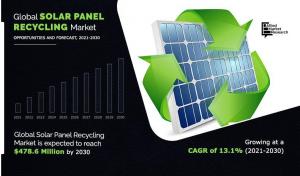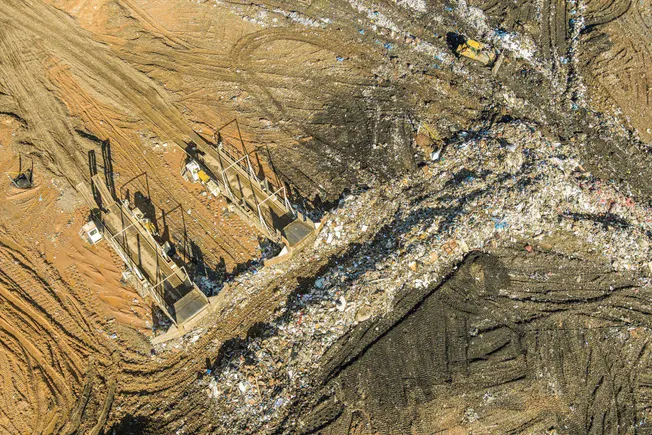Global Solar Panel Recycling Market Report: Advancing Sustainable Development Goals
Executive Summary
The global solar panel recycling market is poised for significant expansion, with projections indicating a market value of $478.6 million by 2030, up from $139.7 million in 2020. This growth, representing a Compound Annual Growth Rate (CAGR) of 13.1%, is fundamentally linked to the global pursuit of the Sustainable Development Goals (SDGs), particularly those concerning clean energy, responsible consumption, and climate action. As the volume of end-of-life photovoltaic (PV) modules increases, the industry’s role in establishing a circular economy for the renewable energy sector becomes critical.
Alignment with Sustainable Development Goals (SDGs)
The expansion of the solar panel recycling industry is a direct contributor to several key United Nations SDGs:
- SDG 7 (Affordable and Clean Energy): By creating a sustainable end-of-life solution for solar infrastructure, recycling ensures the long-term viability and environmental integrity of solar power as a primary source of clean energy.
- SDG 12 (Responsible Consumption and Production): This is the core goal addressed by the market. Solar panel recycling promotes circular economy principles by recovering valuable materials such as silicon, silver, aluminum, and glass. This reduces landfill waste and minimizes the need for virgin resource extraction.
- SDG 9 (Industry, Innovation, and Infrastructure): The market drives innovation in recycling technologies and fosters the development of resilient, sustainable industrial infrastructure dedicated to managing renewable energy waste.
- SDG 11 (Sustainable Cities and Communities): Effective management of solar panel waste is essential for reducing the environmental footprint of urban and rural energy systems.
- SDG 13 (Climate Action): By ensuring the solar energy lifecycle is sustainable, recycling strengthens the overall contribution of solar power to global climate change mitigation efforts.
Market Segmentation Analysis
The market is segmented based on recycling process and panel type, reflecting different technological approaches and material compositions.
-
By Process:
- Thermal: This process was the market leader in 2020, accounting for a 68.9% share due to its high material recovery efficiency.
- Mechanical: Holding a 23.9% share in 2020, this segment is projected to grow at a steady CAGR of 13.4%.
- Laser: An emerging process with potential for advanced and precise material separation.
-
By Panel Type:
- Crystalline Silicon: This segment constitutes the largest portion of the market, driven by the widespread deployment of these panels in various applications.
- Thin Film: Projected to be the fastest-growing segment with a CAGR of 14.6%, reflecting its increasing adoption in the solar energy market.
Regional Market Analysis
Regional performance in the solar panel recycling market is largely influenced by regulatory frameworks and the scale of solar energy deployment.
- Europe: Dominated the global market with a 43.2% share in 2020. The region’s leadership is attributed to robust environmental policies and established recycling frameworks that align with SDG 12. Europe is expected to maintain its lead, with a projected CAGR of 13.7%.
- Asia-Pacific: Forecasted to experience the most rapid growth. The expansion is fueled by large-scale solar capacity increases in China, India, and Japan, which necessitates the development of corresponding recycling infrastructure to meet sustainability targets.
- North America and LAMEA: These regions are progressively adopting solar recycling practices, supported by growing environmental awareness and government incentives promoting renewable energy.
Key Industry Players
The market landscape is shaped by several key organizations committed to advancing sustainable practices in the solar industry. These entities are pivotal in developing the capacity and technology required to support a circular economy.
- Aurubis AG
- Canadian Solar
- Echo Environmental, LLC
- Envaris GmbH
- First Solar
- Hanwha Group
- Reiling GmbH & Co. KG
- Silrec Corporation
- SunPower Corporation
- Trina Solar
Future Outlook and Sustainability Impact
The future of the solar panel recycling market is robust, driven by a global commitment to sustainable energy. Key factors influencing its long-term growth include:
- Regulatory Frameworks: Increasing government regulations mandating producer responsibility for e-waste will accelerate market development.
- Technological Innovation: Advancements in recycling processes will improve the recovery rates of valuable materials, enhancing economic viability and contributing to SDG 9.
- Circular Economy Initiatives: A global shift towards circular economic models ensures that materials from decommissioned solar panels are reintegrated into the supply chain, directly supporting SDG 12.
By 2030, the solar panel recycling industry will be an integral component of the renewable energy sector, ensuring that the transition to solar power is environmentally sustainable and aligned with global development objectives.
Analysis of Sustainable Development Goals in the Solar Panel Recycling Market
1. Which SDGs are addressed or connected to the issues highlighted in the article?
-
SDG 7: Affordable and Clean Energy
The article is fundamentally linked to SDG 7 as it discusses the consequences of the “surge in solar energy adoption” and the “rapid expansion of the global solar industry.” Solar panel recycling is presented as a critical component to ensure the long-term sustainability of this clean energy source.
-
SDG 8: Decent Work and Economic Growth
The article highlights the economic growth of a new industry. It states the “global solar panel recycling market size was valued at $139.7 million in 2020 and is projected to reach $478.6 million by 2030, growing at a strong CAGR of 13.1%.” This growth signifies economic development and the creation of a new market sector.
-
SDG 9: Industry, Innovation, and Infrastructure
This goal is addressed through the discussion of technological advancements and the need for infrastructure. The article mentions the development of “efficient recycling infrastructure to manage aging PV modules” and innovations in recycling processes like “Thermal, mechanical, and laser” technologies, which promise “higher recovery efficiency.”
-
SDG 12: Responsible Consumption and Production
This is the most central SDG in the article. The entire focus on solar panel recycling is about creating sustainable production and consumption patterns. The text emphasizes “waste reduction,” “recovering valuable materials,” and supporting a “circular economy,” which are core principles of SDG 12.
-
SDG 13: Climate Action
While not explicitly mentioned, SDG 13 is implicitly connected. Solar energy is a primary tool for climate action. By addressing the end-of-life waste problem of solar panels, the recycling industry ensures that this climate solution does not create a new environmental problem, thus reinforcing its sustainability and contribution to climate goals.
2. What specific targets under those SDGs can be identified based on the article’s content?
-
Target 7.2: Increase substantially the share of renewable energy in the global energy mix.
The article’s premise is the “increasing installation of solar panels for power generation.” The growth of the recycling market is a direct result of the successful implementation of this target, as more solar panels are being deployed globally.
-
Target 9.4: Upgrade infrastructure and retrofit industries to make them sustainable…and promote the adoption of clean and environmentally sound technologies.
The article directly relates to this target by describing the growth of an industry focused on “environmentally sound” technology. It mentions “advancements in chemical recycling technologies” and the development of infrastructure to manage solar waste, which is a move towards making the renewable energy industry more sustainable.
-
Target 12.2: Achieve the sustainable management and efficient use of natural resources.
This target is addressed by the article’s focus on “recovering valuable materials such as silicon, silver, aluminum, and glass.” This recovery process reduces the need for virgin materials, promoting the efficient use of natural resources.
-
Target 12.5: By 2030, substantially reduce waste generation through prevention, reduction, recycling and reuse.
The article is centered on this target. It explicitly states that the market is driven by “waste reduction” and that “recycling will play a critical role in making solar energy…truly sustainable.” The entire industry’s purpose is to manage and reduce the waste generated by end-of-life solar panels.
3. Are there any indicators mentioned or implied in the article that can be used to measure progress towards the identified targets?
- Market Growth and Value: The article provides specific financial data that can serve as an indicator of progress in building a circular economy. The market’s projected growth from “$139.7 million in 2020” to “$478.6 million by 2030” indicates an increasing capacity to manage solar panel waste (Indicator for Target 12.5).
- Material Recovery Efficiency: The mention of “high recovery efficiency (up to 98% of unbroken cells)” for thermal recycling processes is a direct quantitative indicator for measuring the effectiveness of recycling technologies and the efficient use of resources (Indicator for Target 12.2).
- Regional Market Dominance and Growth: The data that “Europe dominated the global solar panel recycling market in 2020, holding over 43.2% market share” and that “Asia-Pacific is projected to grow rapidly” serve as indicators of regional adoption of sustainable waste management policies and infrastructure (Indicator for Target 9.4).
- Government Policies and Incentives: The article mentions “strong environmental policies,” “established recycling frameworks,” and “government regulations mandating recycling responsibilities.” These policy actions are qualitative indicators of national and international commitment to sustainable production and waste management (Indicator for Target 12.5).
4. Summary of SDGs, Targets, and Indicators
| SDGs | Targets | Indicators |
|---|---|---|
| SDG 7: Affordable and Clean Energy | 7.2: Increase the share of renewable energy. | The “increasing installation of solar panels” and “surge in solar energy adoption” driving the need for recycling. |
| SDG 8: Decent Work and Economic Growth | 8.2: Achieve higher levels of economic productivity through technological upgrading and innovation. | Projected market growth to “$478.6 million by 2030” at a “CAGR of 13.1%,” representing economic expansion. |
| SDG 9: Industry, Innovation, and Infrastructure | 9.4: Upgrade infrastructure and industries for sustainability and adopt clean technologies. | Development of “efficient recycling infrastructure” and adoption of advanced processes like “Thermal, mechanical, and laser” recycling. |
| SDG 12: Responsible Consumption and Production |
12.2: Achieve sustainable management and efficient use of natural resources.
12.5: Substantially reduce waste generation through recycling. |
Recovery of valuable materials like “silicon, silver, aluminum, and glass”; “high recovery efficiency (up to 98%)”.
Market growth driven by “waste reduction” and “circular economy focus”; implementation of “government regulations mandating recycling.” |
Source: natlawreview.com







